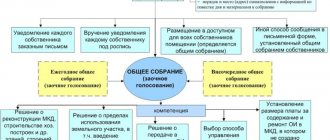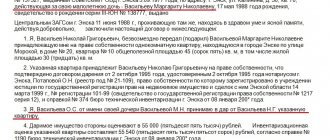Concept
A land exchange agreement is a document fixing the rights and desire of the two parties to exchange plots of land. Based on paragraph No. 3, Article No. 3 of the Land Code of the Russian Federation, such an exchange agreement is regulated by Civil Legislation .
This implies that the contract for the exchange of land will be drawn up based on:
- to the rules from articles No. 454 - No. 491, as well as No. 549 - No. 557 of the Civil Code of the Russian Federation;
- to Article No. 37 of the Land Code of the Russian Federation “Features of the purchase and sale of land plots.”
Invalidity of the contract
The following conditions of the land exchange agreement are considered invalid:
- which limit the further disposal of the land plot, including those that limit the mortgage, lease of the land plot, and other transactions with the land;
- which establish the right of the seller to buy back the land plot at his own request;
- which limit the seller’s liability when third parties claim rights to land plots.
Both parties to the land exchange agreement act as sellers of their property and buyers of the property that they receive under the exchange agreement. Both parties are required to register with the federal registration service:
- exchange agreement in writing;
- your right to the objects of exchange (before registering the exchange agreement);
- everyone’s right to a land plot, which arose on the basis of an exchange agreement (after registration of the exchange agreement).
This exchange agreement can be executed with a transfer deed. The peculiarity of this type of exchange agreement is in the drawing up of an agreement by the parties on the transfer of land plots to each other, which are the subjects of the agreement.
These acts indicate the location of the exchanged plots, their cadastral number, area, and date of compilation. Deeds of transfer are signed by the parties and passed on to each other. The presence of transfer deeds is not a mandatory condition of the land exchange agreement.
Underwater rocks
When concluding an agreement for the exchange of real estate, each party must pay attention to the following information:
- Information must be entered about:
- the size of the plot and its location;
- list of lands, purpose of exploitation;
- price.
- The objects of sale and exchange are plots registered in the cadastral register.
- The document being drawn up must contain the following information, based on the requirements of paragraph 2 of Article No. 8 of the Land Code of the Russian Federation and paragraph 1 of Article No. 18 of the Law on State Registration of Rights:
- location of the site;
- cadastral number;
- category of land and permission for its exploitation.
- The land resource should not be encumbered.
- The site should not be in the status of an easement.
- The land plot should not be pledged to a banking institution.
Features of the land exchange agreement
First of all, it is necessary to take into account that the plots themselves, which are the subject of the transaction, are of equal value. From which it clearly follows that there is no possibility of disputes about the value of these objects.
If a barter is to be concluded regarding two plots, the price of one of which is clearly lower, then the obligation of the party to whom such plot belongs is to pay additionally the corresponding difference in value. This additional payment can be made before the land is transferred to the contracting party of the allotment at a lower price, or immediately after that. In addition, other types of compensation for such price differences are allowed.
The form of compensation, as well as other conditions for its implementation, must be specified in the text of the agreement.
Attention should be paid to the fact that the exchange of one plot for another does not necessarily have to be simultaneous. It is permissible in the agreement to indicate different dates when the direct transfer of ownership rights will take place. According to the established procedure for fulfilling obligations, first one participant transfers its rights to the counterparty, and only then, accordingly, the other.
If the terms for the transfer of land in the document do not coincide, you should refer to Article 328 of the Civil Code of the Russian Federation, where the procedure for reciprocal fulfillment of obligations is reflected at the legislative level. It also regulates situations when one counterparty does not fulfill its obligations, which gives the second party the right to stop fulfilling its obligations or to terminate the transaction altogether and demand compensation for losses from the guilty party. The very aspect of transferring ownership rights to exchangeable land plots is prescribed in Article 570 of the Civil Code of the Russian Federation. According to this article, plots of land acquired in this way (exchange) pass into the possession of the other party after the mutual fulfillment of their obligations specified in the document by both parties.
Important features of barter regarding the seizure of land acquired through exchange are spelled out in Article 571 of the Civil Code of the Russian Federation. According to the rules of purchase and sale established by the legislation of the Russian Federation, the object being sold must be free from encumbrance by third parties. The same rules apply to barter. However, an exception is possible: the second party is aware of the existing encumbrances and voluntarily agrees to accept such an object. Otherwise, certain consequences will follow for the unscrupulous participant in the transaction: he will be forced not only to compensate losses to the counterparty, but also to return the received land plot.
Registration procedure
When drawing up an agreement to exchange a land plot, relations between the parties to the transaction are regulated by the Land and Civil Code.
Attention! The subjects of such relations can only be those persons to whom the ownership right is registered.
The algorithm for drawing up a land exchange agreement can be divided into several stages : collecting documents and drawing up an exchange agreement for a land plot.
The agreement must be drawn up:
- in accordance with Article No. 550 of the Civil Code of the Russian Federation;
- the structure of writing is regulated by the Letter of Roskomzem dated October 19, 1994, No. 2-16/1629;
- after the site has been assessed and a certificate of the assigned cadastral value has been provided.
List of all required documents
List of required documents for exchanging a land plot:
- copies of personal documents: passports, tax identification numbers of the parties to the transaction;
- documents for the land plot;
- certificates confirming the absence of encumbrances or restrictions on the land;
- an act of establishing a standard price for exchanged plots, issued by authorized land management bodies;
- summary statements of valuation of buildings located on the exchanged plot of land;
- cadastral passports;
- barter agreement.
Contents of the agreement
The following must be included in it:
- name and date of conclusion of the contract in words;
- place of conclusion of the document;
- personal data of the two parties: Full name the participant in the transaction in full, date of birth, passport details and which authority issued the document, place of registration and actual address of residence;
- subject of the agreement;
- encumbrances of the exchanged plots;
- restrictions on the use of exchanged plots;
- rights and obligations of the parties;
- responsibility of participants;
- final provisions;
- addresses, bank details of areas of contractual relations;
- endorsement of the document with signatures; annexes to the agreement;
- receipts confirming payment of the state fee for registering the exchange agreement and for issuing a certificate certifying the right to property.
Important points that transaction participants should pay attention to are:
- A clause on restrictions or encumbrances on the areas selected for exchange;
- if a restriction is imposed on the site by a public easement, then the owner must provide a regulatory legal act that fixes the reason and duration of the restriction;
- if a plot is restricted by a private easement, the owner must provide an agreement of adjacent landowners and a court decision.
- The clause defining the subjects of the agreement and their parameters.
- The point is the responsibility of the parties if the plots are not equal in price.
- Paragraph final provisions.
- The party(ies) bearing additional costs associated with the execution and registration of the transaction.
Mandatory land assessment
If the owner of a land resource has decided to exchange a plot for new land, then he is obliged to conduct an assessment of the land resource in his ownership , in accordance with Article No. 66 “Land Assessment” of the Land Code of the Russian Federation.
A cadastral assessment will help determine:
- the market value of the exchanged plot in accordance with Article No. 8 of the Federal Law “On Valuation Activities in the Russian Federation”;
- the cost of land plots through state cadastral valuation.
Land property valuation can be carried out in three ways:
- through independent research of supply and demand for the land being sold;
- based on data on the cadastral value of the site;
- using the services of an independent appraiser.
The procedure for assessing land when concluding a contract includes the following steps:
- the decision of the owner of land property to evaluate his property;
- select an independent appraiser and enter into a cooperation agreement with him;
- conducting an independent assessment of the land plot by an appraiser in order to determine the market value of the subject of exchange;
- drawing up a final report on the work done;
- signing certificates of completed work to assess the site;
- delivery of the result to the owner of the site.
Do I need to contact a specialist?
There are two ways to draw up a document for exchanging land for land : independently and by using the services of a specialist.
| Drawing up a contract yourself | Document preparation using the services of a specialist | |
To independently conclude a document, you must have with you:
The main task when independently drawing up an exchange agreement:
To protect yourself from fraud, it is better to draw up a preliminary agreement to complete a land exchange transaction and consult in detail on each of the basic points with a lawyer. | To formalize a land exchange agreement with a specialist, the owner must provide:
Specialist independently:
| |
| Advantages |
|
|
| Flaws |
|
|
Drawing up a land exchange agreement
According to Article 550 of the Russian Civil Code, an agreement for the sale of real estate is drawn up in writing by drawing up one document signed by the parties. Consequently, an agreement for the exchange of plots of land must be concluded only in writing .
Failure to comply with the mandatory requirements of the legislator regarding the form of the agreement entails its invalidity.
The standard format for an agreement for the exchange of plots of land is established by the Letter of Roskomzem dated October 19, 1994 N 2-16/1629.
An agreement for the exchange of plots of land as real estate requires state registration of the rights of the new owners in the branch of Rosreestr at the location of the corresponding plots of land that are the subject of the exchange agreement.
An agreement for the exchange of plots of land must describe the characteristics that individualize the plots being exchanged, which are the subject of this agreement:
- Cadastral numbers of the land plots being exchanged;
- Area of alienated plots;
- The intended purpose of the relevant lands, which include the exchanged plots;
- The purpose of exploitation of land plots;
- Real estate objects located on the exchanged plots of land with the designation of their ownership.
The land exchange agreement is accompanied by graphic plans (drawings) of the land plots that are the object of the exchange. The parties to the agreement should also take care of the assessment of the exchanged plots of land in accordance with the established cadastral value, as well as the assessment of various structures and other real estate located on the land.
The assessment is formalized in the form of acts of determining the cadastral value of the alienated land and summary statements of assessment of buildings and structures attached to the exchange agreement. When drawing up an agreement for the exchange of plots of land, the parties are obliged to inform their counterparties:
- about the existence and legal nature of existing land disputes and conflicts regarding the exchanged plots or their absence;
- about the presence of existing easements;
- on the transfer of the exchanged plot of land to a third party;
- on the transfer of alienated land as collateral.
The territorial boundaries of all lands encumbered with the rights of third parties and the general content of these rights-encumbrances are indicated on the drawing (graphic plan) of the corresponding plot of land. The agreement itself also reflects restrictions on the rights of owners associated with sanitary protection, technological and other zones established on the land or the classification of lands of the exchanged plot (or part thereof) as land for recreational, environmental or historical and cultural purposes.
Ways to find out who owns a plot of land
Do you need your spouse's consent to purchase real estate?
Recognition of ownership rights to unauthorized construction
Subtleties of using maternity capital when purchasing an apartment in a new building
How to write a complaint to the developer
Ways to re-register a mortgage to another person
What other objects of exchange could there be?
House
If there is a house on a plot of land, then when drawing up an agreement, the parties to the transaction are obliged to:
- discuss what to do with registered persons in this area;
- provide complete and detailed information about the building.
Because if minor citizens of the Russian Federation are registered in the house, then it is necessary to ensure that their interests are not infringed and that all permissions and consents are obtained from the guardianship authorities. In such a situation , the property will be transferred under a deed of transfer , which is attached to the agreement for the exchange of land for land.
Apartment
If the object of the contract is a plot and an apartment, then the exchange agreement must indicate the following information:
- the exact address of the apartment;
- its total cost;
- a list of persons who will own the right to use the apartment after the transaction is completed.
If there are several owners at once, then the fact of transfer of the apartment must be agreed upon with all owners.
Attention! If one of the shares belongs to a minor child, before signing the land exchange agreement, permission from the guardianship authorities will need to be attached to the documents.
Movable property
To exchange land for land for movable property, you must submit an agreement to the State Traffic Inspectorate , where the car will be checked:
- the presence of a wanted car;
- for restriction (arrest);
- for technical condition.
After the above procedures, the newly-minted owner receives a certificate of movable property on the day of submitting the contract.
Read about how to exchange land and other real estate for a car here.
Registration procedure
To officially register an agreement for the exchange of land for land, the parties to the transaction must contact the Rosreestr service or the MFC. When registering a document, two parties must provide:
- application for the registration procedure;
- internal passports of citizens of the Russian Federation, or documents for legal entities;
- notarized power of attorney for a representative, if the party cannot personally represent his own interests;
- real estate exchange document and transfer deeds;
- title documents for ownership;
- certificate from the Unified State Register of Real Estate;
- cadastral documents;
- receipt for payment of state duty.
Registration of an exchange agreement for a share of a plot is possible only after notarization . To do this, the owner must:
- obtain a boundary plan for part of the site by contacting a cadastral engineer;
- send to other owners of the plot an information notice about the conclusion of an exchange agreement with an offer to sell the part on the preemptive right.
Important! If within a month a positive response was not received to the notification, but a refusal was sent, then the agreement is sent to the notary’s office for certification.
Only after receiving a certification mark from a notary, subsequent registration actions in Rosreestr regarding the exchange agreement will take place according to the general rules.
Algorithm of actions for registering an agreement
In order for the transfer of rights under a land exchange agreement to be officially registered, the parties need to contact the Rosreestr service or the Multifunctional Center. When registering, counterparties must submit the following set of documents:
- application for registration actions;
- general civil passports for the parties to the transaction, or documents for legal entities;
- a notarized power of attorney for the representative, if the parties used this option for conducting the transaction;
- exchange agreement and transfer deeds;
- title documents for property assets - certificate of title, extract from the state register of the Unified State Register of Real Estate, vehicle registration certificate, etc.;
- boundary plan for the land, if the site has not previously undergone the cadastral registration procedure;
- payment order confirming payment of the state duty (in 2017, for citizens the state duty is 2,000 rubles, for enterprises - 22,000 rubles).
Depending on the type of application, registration actions will be completed within 7 to 12 days (if applying through the Multifunctional Center, registration will take two days longer). After completing the registration stage, the new owner of the land plot will receive an extract from the state register of the Unified State Register of Real Estate.
Registration of exchange agreements for a share of a plot is possible only after notarization of the transaction. To do this, the owner of the site must follow the following algorithm of actions:
- obtain a boundary plan for the share through a cadastral engineer;
- send other owners a notice of the conclusion of an exchange agreement with an offer to buy out the share with a preemptive right;
- If within a month there is no consent to the specified proposal, or a refusal is received, the agreement is submitted to the notary’s office for certification.
After the notary’s certification mark, further registration actions in Rosreestr will take place according to the general rules.







